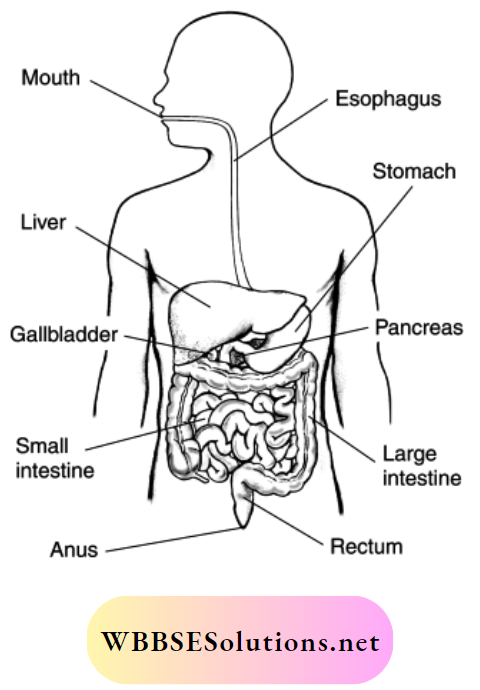Chapter 3 Physiological Processes Of Life Nutrition Long Answer Type Questions
WBBSE Life Science And Environment Class 9 Solutions
Question 1 Mention the different types of plant nutrition with examples.
Answer:
Different types of plant nutrition with examples:
Plants perform nutrition in different ways, which are mentioned below:
1 Autotrophic nutrition:
In this process, plants perform nutrition by synthesising their own food from simple inorganic matter by photosynthesis followed by assimilation of the simple sugars produced in this process.
Example: All green plants, certain blue-green algae or cyanobacteria, protists like Euglena, Chrysamoeba and photosynthetic bacteria like Rhodopseudomonas, Rhodospirillum etc.
Read and Learn More Class 9 Life Science Long Answer Questions
2 Heterotrophic nutrition:
The plants which cannot carry photosynthesis due to the lack of photosynthetic pigments and depend on other living or dead or decaying organic matter for food are called heterotrophs. Their mode of nutrition is called heterotrophic heterotrophic nutrition discussed below.
1. Parasitic nutrition: In this process, some plants grow on other plants (called hosts) and draw nutrition from them.
Example: Plants like Cuscuta, Rafflesia, etc. show parasitic nutrition.
2. Saprophytic nutrition: In this process, some plants draw nutrition from dead organisms and decaying organic matter.
Example: All types of fungi, like Agaricus, Mucor, Penicillium etc. perform saprophytic nutrition.

3. Symbiotic nutrition: In some cases, two different plants live in close association and mutually benefited from that association. This mode of nutrition is called symbiotic nutrition.
Example: Lichen is a symbiotic association of algae and fungi. Here, the fungal part provides the settling platform and water to the algal part. In return, the algae synthesise and supply food.
4. Insectivory: Certain plants draw nitrogenous nutrients from small insects. These plants have special organs, typically modified for trapping insects. This mode of nutrition is called insectivory.
Example: Pitcher plant, sundew, and bladderwort are some plants which show insectivory.
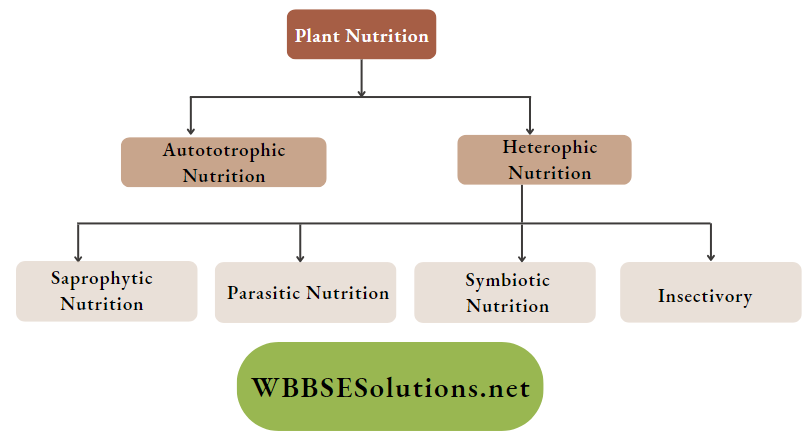
2 Why animal nutrition is also called heterotrophic nutrition? Briefly describe different types of animal Nutrition.
Answer:
The reason behind animal nutrition being called heterotrophic nutrition:
Animals cannot synthesise their own food from simple inorganic materials like CO2 and water. For nutrition, they depend on other organisms.
They depend on plants or other organisms for their food. As animals depend on other organisms for food their mode of nutrition is called heterotrophic nutrition.
Different types of animal nutrition:
The following types of nutrition are found in animals:
1 Parasitic nutrition: Some animals draw nutrients from other living organisms (hosts), thereby benefiting themselves and harming the others. This mode of nutrition is called parasitic nutrition.
Example: Tapeworms, roundworms, Plasmodium etc. live inside the body of the host and are called endoparasites. Lice, ticks etc. live on the body surface of the host and are called ectoparasites.
2 Saprozoic nutrition: Some animals draw nutrients from decaying organic matter. This mode of nutrition is called saprozoic nutrition.
Example: Earthworms and Amphitrite (a marine annelid) show saprozoic nutrition.
3 Symtiotic nutrition: Sometimes, two organisms develop a close association between them, from which both are nutritionally benefited. This type of nutrition is called symbiotic nutrition.
Example: E. coli gets shelter and food in human intestine. In return, they synthesise vitamin.
4 Coprophagy: Faeces of many animals contain nutritionally important substances. Some animals draw nutrients by consuming their own faeces, or of other animals. This type of nutrition is called coprophagy.
Example: Rabbits, guinea pigs, dung beetles etc. show coprophagy.
5 Sanguinivory: Some animals draw nutrients from blood of other animals. This mode of parasitic nutrition is called sanguinivory.
Example: Auchmeromyia (blood-sucking maggot), leeches, vampire bats etc. show this type of nutrition.
WBBSE Life Science And Environment Class 9 Solutions
Question 3 Distinguish between autotrophic nutrition and heterotrophic nutrition.
Answer:
Differences between autotrophic nutrition and heterotrophic nutrition:
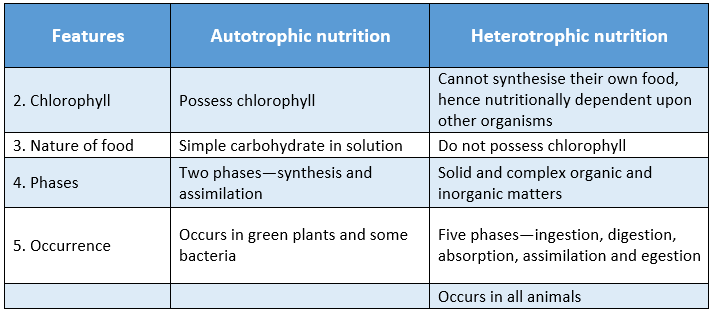
Question 4. Compare parasitic, saprophytic and symbiotic nutrition.
Answer:
Comparison among parasitic, saprophytic and symbiotic nutrition:
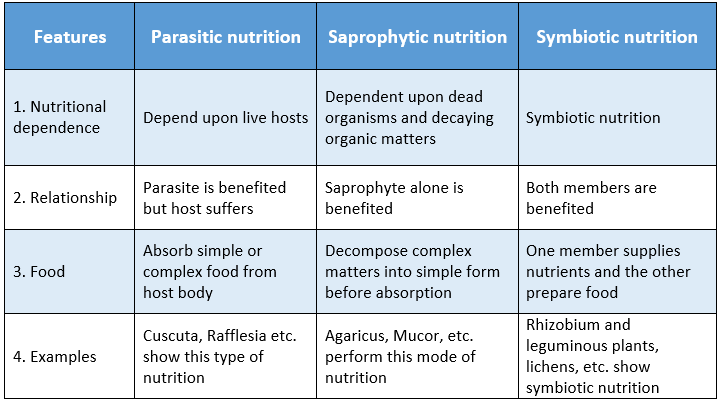
Question 5 Distinguish between holophytic and holozoic nutrition.
Answer:
Differences between holophytic and holozoic nutrition:
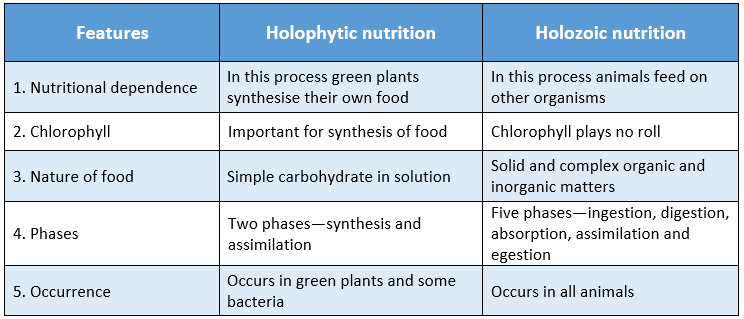
WBBSE Life Science And Environment Class 9 Solutions
Question 6 Briefly discuss the different phases of holozoic nutrition.
Answer:
Phases of holozoic nutrition:
Holozoic nutrition involves five different phases, which are mentioned below:
1 Ingestion:
In this step, food materials are taken into the mouth, chewed by teeth and pushed into the food pipe or oesophagus. Besides teeth, the tongue also helps in this process. Salivary secretion makes the food bolus softer to facilitate this process.
2 Digestion:
This step involves the mouth, stomach, liver, pancreas and small intestine. Several enzymes are secreted inside these organs from the glandular cells. In the presence of water, these enzymes act upon respective food materials and help in the breakdown of the matter into simple and absorbable forms. This step is known as hydrolysis or digestion of food.
3 Absorption:
Mainly small intestine is involved in this process. The stomach and large intestine also play some role in it. End products of digestion are taken into the blood capillaries, where they are absorbed.
4 Assimilation:
All tissues of the body are involved in this process. In this penultimate phase of holozoic nutrition, various nutritionally important compounds and ions, absorbed in the blood from GI tract, enter into cells and become a part of the protoplasm.
5 Egestion:
This process involves the rectum and anus of the large intestine. In this last phase, undigested food matters are temporarily stored and then discharged as faeces.
Question 7 Briefly describe the structure of the human alimentary canal.
Answer:
Structure of the human alimentary canal:
The long tube or passage extending from mouth to anus through which food passes during digestion is called the alimentary canal.
It is composed of the following parts:
1 Mouth:
It is the opening of the alimentary canal, guarded by a pair of lips. The inner chamber is known as the buccal cavity, which consists of a muscular tongue at the base. The cavity also consists of an upper and a lower jaw, fitted with a maximum of 32 teeth (16 on each jaw).
2 Pharynx: It is a slightly swollen, muscular chamber behind the buccal cavity.
3 Oesophagus: It is a straight, vertical, muscular tube, that carries food from the pharynx to the stomach.
4 Stomach:
It is a J-shaped muscular sac, present on the left side of the upper abdominal cavity. It consists of four regions-the cardiac stomach (upper portion, close to the heart), fundic stomach (wide middle portion), the body (portion between fundic stomach and pyloric stomach) and the pyloric stomach (lower portion, attached to the duodenum).
5 Small intestine:
It is a very long, narrow and highly convoluted tube, that extends from the stomach to the large intestine and occupies a maximum portion of the abdominal cavity. It has three portions-duodenum (emerging from the stomach), jejunum (the middle region) and ileum (meets the large intestine).
6 Large intestine:
This tube is less coiled and broader than the small intestine. It consists of three parts- caecum (the dilated portion, where the small intestine meets), colon (the tubular part consisting of four regions-ascending colons, transverse colon, descending colon and sigmoid colon), rectum (a wide tube, next to the sigmoid colon, that proceeds downward and opens through the anus).
WBBSE Life Science And Environment Class 9 Solutions
Question 8. State the differences between small and large intestines. Distinguish between the stomach and small intestine.
Answer:
Differences between small and large intestines:
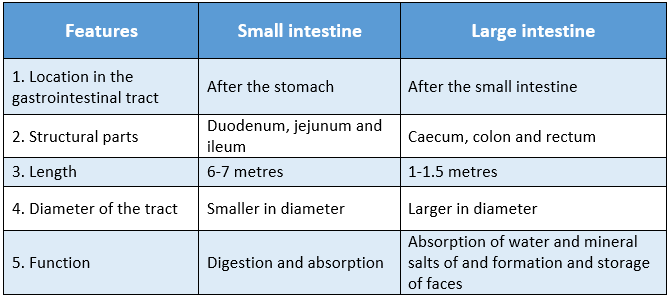
Differences between the stomach and small intestine:
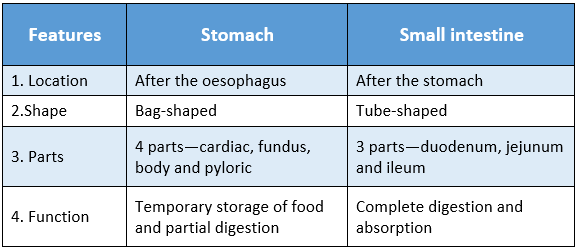
Question 9 Briefly describe the name, location and secretary substance of different digestive glands of the human alimentary system.
Answer:
Different digestive glands of the human alimentary system:
The human alimentary system consists of different types of digestive glands.
These are discussed below:
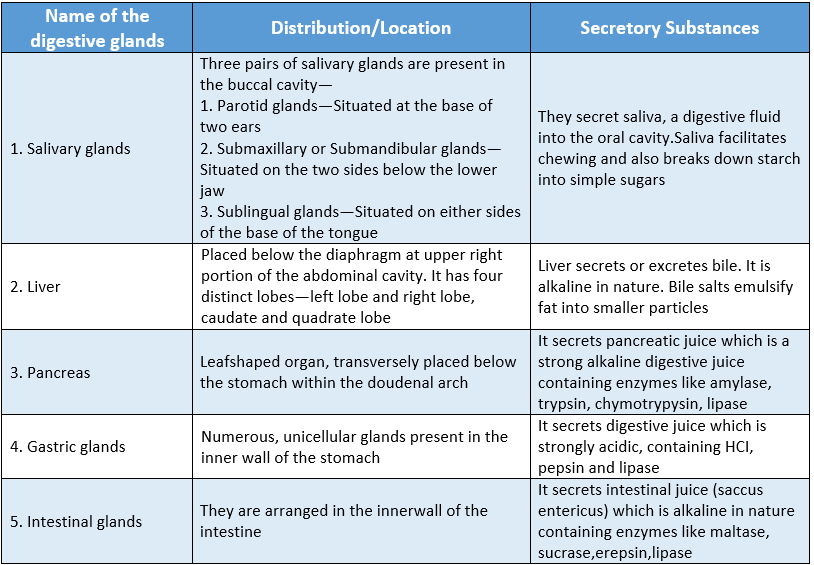
WBBSE Life Science And Environment Class 9 Solutions
Question 10. Mention the names, sources and roles of the different amylolytic enzymes in digestion.
Different amylolytic enzymes in digestion:
The names, sources and roles of different amylolytic enzymes that take part in digestion are given below:
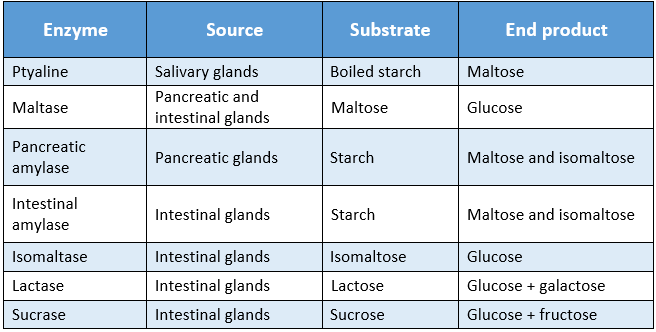
Question 11. Mention the names, sources and roles of different proteolytic and lipolytic enzymes in digestion.
Different proteolytic enzymes in digestion:
The names, sources and roles of different proteolytic enzymes are given below:
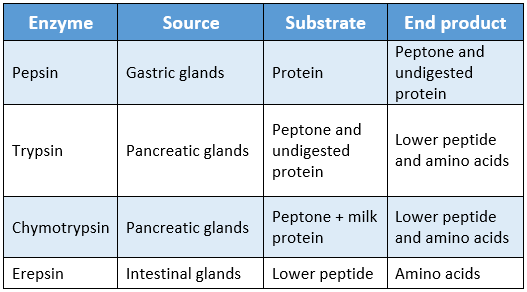
Different lipolytic enzymes in digestion:
The names, sources and roles of different lipolytic enzymes are given below:
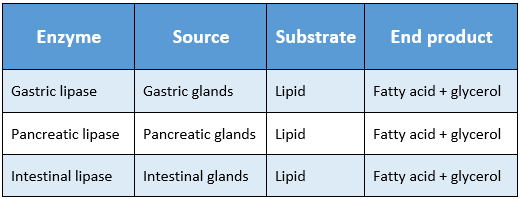
WBBSE Class 9 Life Science Solutions
Question 12 How does absorption of digested food matter occur in the human GI tract? Briefly explain the method of assimilation of nutrients in the human body.
Answer:
Method of absorption of food:
Absorption mainly occurs in the small intestine. The inner wall of the intestine develops many small finger-like projections called villi (singular-villus).
Each villus has a central lymph duct called lacteal, and a few blood capillaries. Monosaccharides, amino acids and glycerol are absorbed in the blood capillaries. Fatty acids are taken into the lacteals.
Besides the small intestine, a few materials are absorbed through the epithelial lining of the stomach and large intestine. These include water, alcohol, few salts and drugs.
Method of assimilation of food:
From the intestine, blood carries glucose, fructose, amino acids and a few fatty acid molecules to the liver, through hepatic portal vessels. After supplying nutrients in the liver, this blood moves to the systemic circulation.
Lymph ducts carry simple fat molecules and finally transfer them to the systemic circulation. As a result, all nutrients reach every tissue and cell through blood. Finally, these essential molecules are incorporated into the protoplasm of the cells.
Question 13 Briefly explain the fate of the nutrients in a living cell. Mention the features of a balanced diet.
Answer:
The Fate of Nutrients in a living cell:
The absorbed nutrients get assimilated within the cells and carry out different functions. Monosaccharides participate in cellular respiration as respiratory substrates.
These are oxidised to generate energy, which is necessary for different life activities. Proteins help in building body cells and lipids are kept as stored matter.
Vitamins act as coenzymes and minerals act as cofactors of various enzymes, or as fundamental components of some cellular molecules. Almost all end products of digestion undergo necessary changes within the cells through the process of metabolism.
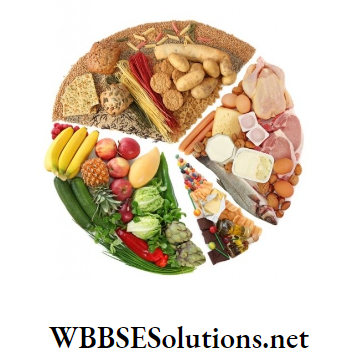
Features of a balanced diet:
Foods, that we take every day, do not always make a balanced diet. Moreover, any single food material cannot be treated as a balanced diet.
It should have certain features which are as follows:
1. It should help to maintain the growth and perfect shape of the body.
2. It should perfectly meet the calorific demand of a body.
3. It should help to develop resistance against infection.
WBBSE Class 9 Life Science Solutions
Question 14 What do you understand by the term mechanical digestion? Mention the different types of mechanical digestion.
Answer:
Mechanical digestion:
The process by which dry and semi-solid foods are converted into smaller fragments in the GI tract and also the process by which the food is pushed forward along the G1 tract is called mechanical digestion.
Different types of mechanical digestion:
Generally, mechanical digestion is of three types:
1 Mastication or chewing: Food matters taken into the buccal cavity undergo mechanical processing. Different types of teeth help to cut, tear and masticate the food matter into small particles. Saliva moistens it to form a soft and smooth dough-like matter. This whole process is known as mastication or chewing of food.
2 Swallowing: The process by which the food passes from the mouth to the pharynx and then enters the oesophagus by shutting the epiglottis, is known as swallowing or deglutition.
3 Movements of the GI tract: Movements of the gastrointestinal tract occur, which help in the forward movement of food. Generally, two types of movements are seen-peristalsis and segmentation movement.
Question 15 Describe the different phases of protein digestion with the help of a suitable schematic diagram.
Answer:
Different phases of protein digestion:
Digestion of protein occurs stepwise, mostly in the stomach and small intestine. Several proteolytic enzymes (enzymes that break down protein) influence the process of protein digestion.
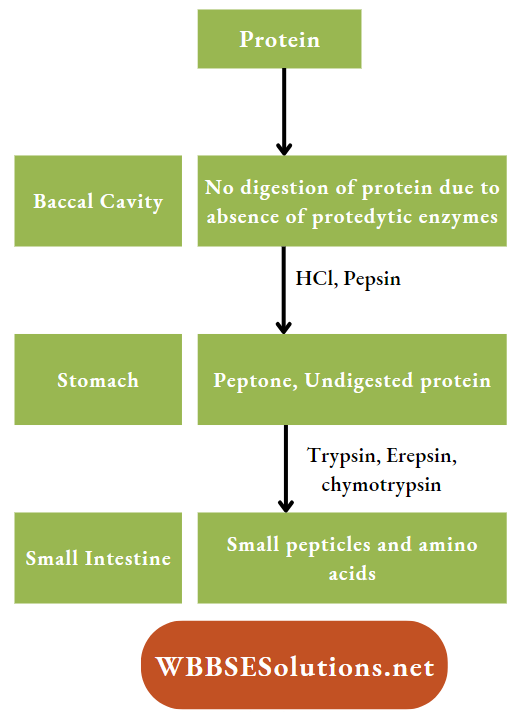
The different phases of protein digestion are as follows:
1 Digestion in the buccal cavity: Since no proteolytic enzyme is present in the buccal cavity, protein digestion does not occur here.
2 Digestion in the stomach:
This is the site where protein digestion starts. Upon entering the stomach, the food is converted into chyle after it gets mixed with the gastric juice secreted from the gastric glands of the stomach.
The presence of HCl in the gastric juice makes the chyle acidic and activates the proteolytic enzyme pepsin. Pepsin converts proteins into peptones. However, pepsin is unable to execute the complete digestion of proteins into peptones and therefore, incomplete digestion of proteins occur in the stomach.
3 Digestion in the small intestine:
Upon entering the small intestine, the undigested proteins and peptones mix with the pancreatic and the enteric juices. Proteolytic enzymes, named trypsin and chymotrypsin present the pancreatic juice hydrolyse peptones and undigested proteins into small peptides.
After that, these small peptides are broken down into amino acids by the action of another enzyme, called erepsin, which is present in the enteric juice. These amino acids are then absorbed into the blood with the help of villi present in the small intestine.
WBBSE Class 9 Life Science Solutions
Question 16. Explain the different steps of carbohydrate digestion with the help of a suitable schematic diagram.
Answer:
Different steps of carbohydrate digestion:
Carbohydrate digestion occurs mainly in the buccal cavity and in the small intestine.
1 Digestion in the buccal cavity:
Carbohydrates especially boiled starch’ present in the food, mix with Ptyaline present in the salivary juice and is converted to maltose and isomaltose. Maltase present in saliva converts maltose into 2 molecules of glucose.
The quantity of maltase in the saliva is very low and therefore, small amounts of glucose are formed in the buccal cavity by the action of the salivary enzymes.
2 Digestion in the stomach:
Digestion of carbohydrates does not occur in the stomach due to the absence of amylolytic or carbohydrate-digesting enzymes. Only a small amount of sucrose is hydrolysed into glucose and fructose with the help of HCI.
3 Digestion in the small intestine:
In the small intestine, both boiled and unboiled starch gets converted into maltose by the action of pancreatic amylase. Maltase present in enteric juice then breaks down maltose into 2 molecules of glucose. The majority of the ingested starch is broken down by pancreatic amylase.
But if any portion of the starch is still left unbroken, then intestinal amylase will act on it to break it down into simpler components. Moreover, intestinal lactase and sucrase hydrolyse lactose into glucose and galactose and sucrose into glucose and fructose respectively.
In this way, complex carbohydrates are broken down into simple monosaccharide units which are then absorbed in the body.
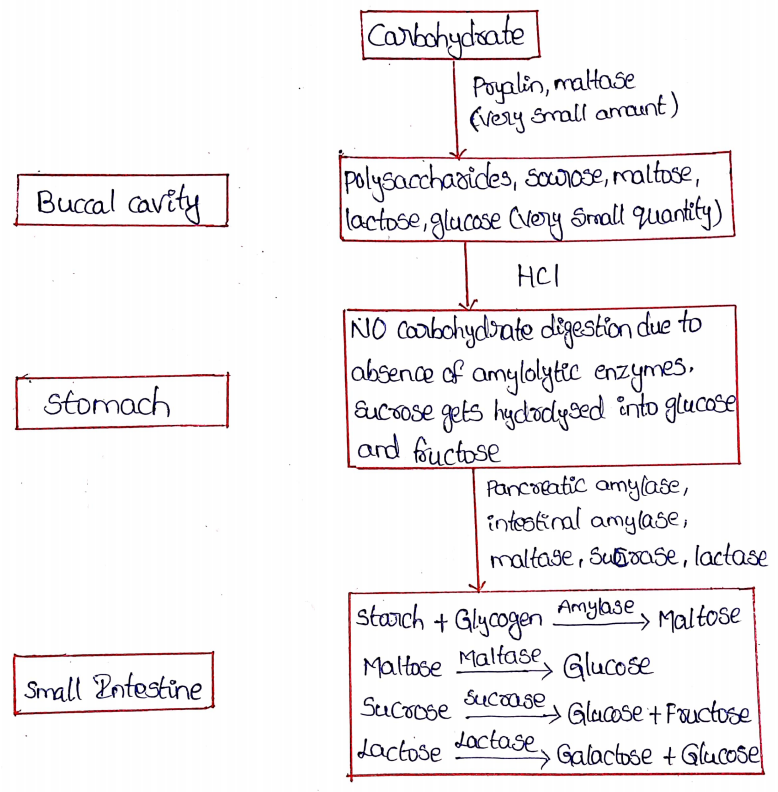
Question 17 What do you mean by fat digestion? Briefly describe the different steps involved in fat digestion.
Answer:
Fat digestion:
The process by which fats or lipids are broken down into fatty acids and glycerol in the alimentary canal with help of the enzyme lipase and bile salts present in the digestive juice is called fat digestion.
Different steps of fat digestion:
Fat digestion mainly occurs in the stomach and in the small intestine. The different steps of fat digestion are described below.
1 Digestion in the buccal cavity: Fat digestion does not occur in the buccal cavity due to insufficient amount of fat digestive enzymes.
2 Digestion in the stomach:
When the ingested food enters the stomach, it gets mixed with the gastric juice. Gastric lipase, present in the gastric juice, breaks down fats into fatty acids and glycerol.
Digestion in the small intestine: As the lipid molecules enter the duodenum of the small intestine, they get mixed with the bile, pancreatic and intestinal juices. The bile salts present in the bile juice emulsify the lipid molecules.
Then pancreatic and intestinal lipases act on the emulsified fats and break them into fatty acids and glycerol. In this way, fat is broken down into fatty acids and glycerol which are then absorbed in the bloodstream.
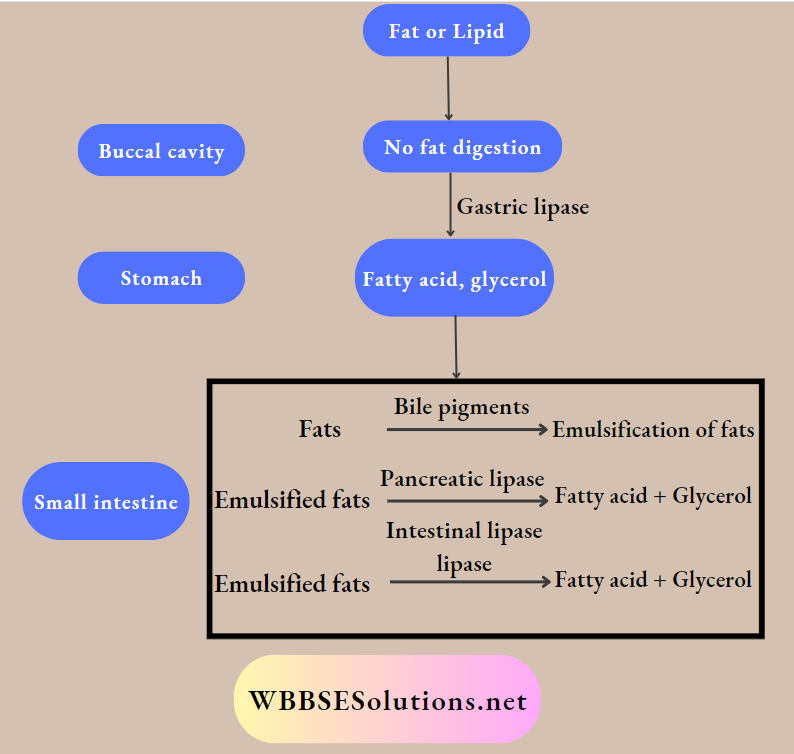
WBBSE Class 9 Life Science Solutions
Question 18 What is basal metabolic rate? Mention the factors that regulate basal metabolic rate.
Answer:
Basal Metabolic Rate (BMR):
Basal metabolic rate is the amount of energy given out per hour and per square metre of body surface area of a person who is awake, but at complete mental and physical rest in a comfortable environment and in a post-absorptive state, i.e. 12 to 18 hours after a meal.
It is the minimum amount of energy required to maintain vital physiological functions such as breathing, blood circulation etc. The BMR of a healthy adult man is 40 kcal/hour/sq. metre body surface area and the BMR of a healthy adult female is 37 kcal/hour/sq. metre body surface area. It is generally measured with the help of Benedict Roth’s apparatus.
Factors regulating basal metabolic rate:
The factors which regulate the basal metabolic rate are discussed below:
1 Body surface area: BMR is directly proportional to the body surface area.
2 Age: Children have greater body surface area as compared to their body weight, therefore, in children, BMR is more than in adults.
3 Sex: Males have greater BMR than females.
4 Nutritional status: Long-term malnutrition causes a decrease in BMR.
5 Weather: People living in temperate regions have greater BMR than people living in warmer areas.
Benedict Roth apparatus
6 Endocrine glands: Hormones secreted from the thyroid, adrenal glands and anterior pituitary, increase BMR.
7 Body temperature: BMR increases or decreases with an increase or decrease in body temperature.
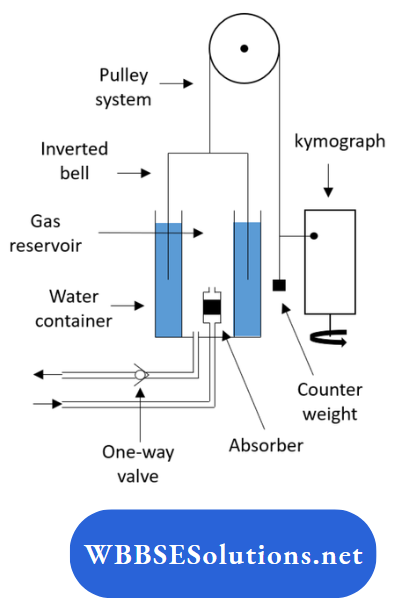
Question 19. State the significance of metabolism. What do you mean by metabolic disorders and state the reasons for metabolic problems in humans?
Significance of metabolism:
The significance of metabolism is as follows:
1 Maintenance of body homeostasis: Metabolism is essential for the normal functioning of all biochemical reactions taking place in the body.
2 Generation of energy: Metabolism provides energy, which is needed for the normal functioning of various body processes.
Metabolic disorders/problems:
The condition in which normal body metabolism is altered, is called metabolic disorders or problems. Generally, metabolism decreases or sometimes halts in such conditions.
Reasons for metabolic disorders in humans:
The reasons for metabolic disorders in humans are as follows:
1. Insufficient enzymes: A decrease in functional enzymes is one of the main reasons of metabolic problems.
2 Insufficient hormones: Hormones generally regulate several metabolic processes. In the absence of such hormones, these metabolic processes are altered leading to metabolic problems.
3 Genetic problems: Generally mutations of genes, involved in different metabolic pathways, lead to metabolic disorders.
WBBSE Class 9 Life Science Solutions
Question 20. Mention the role of the small intestine in the digestion of food. OR, Describe the digestion of food in the small intestine with the help of a suitable schematic diagram.
Answer:
Digestion in the small intestine:
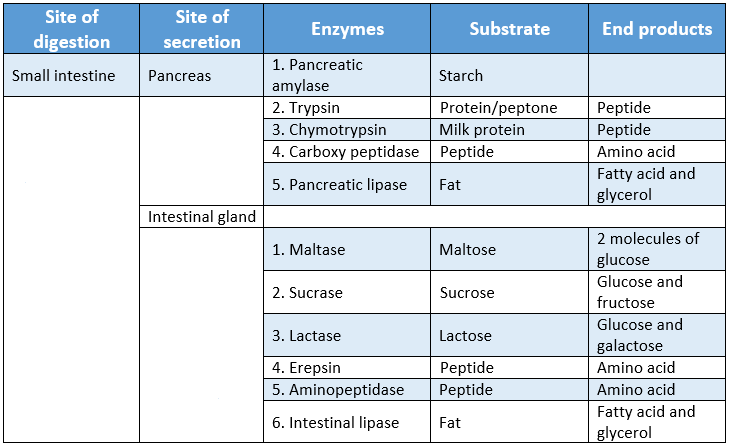
Question 21. Mention the determining factors of a balanced diet. List a balance diet chart of an adult person of your own choice.
Factors of a balanced diet:
The determining factors of a balanced diet in humans are:
1. Sex
2. Age
3. Metabolism
4. Physical activity
5. Growth and pregnancy
6. Body weight
7. Weight and size
8. Genetics
9. Hormone levels
10. Any illness
Diet chart for a healthy person:
A healthy diet chart for adults:
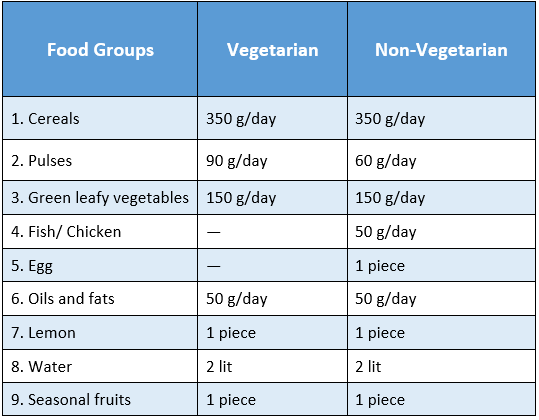
WBBSE Class 9 Life Science Question And Answer
Question 22. Mention the name, symptoms and causes of some metabolic diseases in the human body.
Answer:
Name, symptoms and causes of some metabolic diseases:
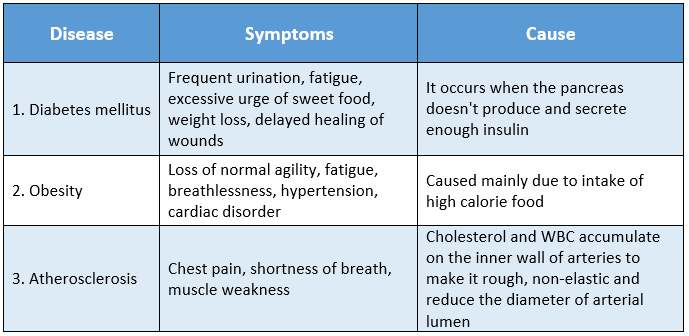
Question 23. Draw a labelled diagram of the human alimentary system.
Answer:
A labelled diagram of the human alimentary system:
